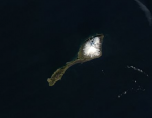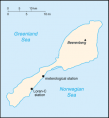Jan Mayen
Arctic OceanLevel of surfing
Advanced
Quality of surf
Average
Net code
sj
Area
373
Coastline
124 km
Climate
Arctic Maritime, frequent storms
Hazards
Very Isolated, Extreme Cold, Severe Storms, Difficult Access
Best Months
October - February
Population
30
Currency
Norweigan Krone (NOK) Norwegian kroner per US dollar - 6.4117 (2006)
Time Zone
(CET) UTC+1
Special Requirements
Private Beaches, Special Pass / Permits, Lengthy VISA Process, Non tourist Friendly
surfing

NASA: Jan Mayen; 2005
This part of the world is where North Atlantic swell is born, as a result, you are often too close to the genesis area of these storms, fronts and depressions to enjoy clean swell. Summer is your only season here (Jun-Aug). The deciding factor is the temperature, even with the latest technology available, human life is basically unsustainable in these waters for any real period of time. You will need titanium vests, drysuts, experimental heating systems and thats just to start. Most surfers use a board with a 'diamond deck', so inbuilt onboard texture on the deck, similar to what is used in the windsurfing industry. The type of wax you would need to be effective here would be liquid at normal room temperature and so transport of it to and from the break once on your board is difficult.
Winter is dark virtually all year round and ice is a big problem, apart from the reality of hitting something it effectively attenuates any swell in the area. The months either side are really pushing the limits of human endurance but with a few hours of sunlight on average it is a possibility for the well prepared. Swells here are massive but often a near blizzard of wind and spray. Summer will bring respite as the storm cells retreat just a little further north.
Hypothermia is a real problem here and drysuits can be difficult to manouvre in. The most exciting aspect of surfing here is that it is truly pushing the boundaries of what surfing is. For once, technology is being dragged kicking and screaming behind some of the expeditions to areas such as this, any day now it is going to catch up and when that happens, extreme cold water surfing will eventially become a mainstream activity. Waves in areas such as this will be the new discoveries and uncrowded paradises of the next generation of surfers. Trade in your boardies for a 7mm steamer, booties and hood and get onboard!
introduction

Map of Jan Mayen; From CIA World Factbook 2002, public domain
Jan Mayen is an island between Greenland and Norway in the Arctic Ocean. It is a distinct dependency under Norway.
The island ia quite remote and desolate, some parts of it are covered in glaciers with some moss and grass. There are also mountains and volcans there...the long dormant Haakon VII Toppen/Beerenberg volcano (2,277 meters) resumed activity in 1970 (it is the northernmost active volcano on earth!).
history

Jan Mayen Island was discovered by the Dutch whaling captain in 1614 and used for international whaling/trapping settlements. Since 1930 it was administered by the governor of Svalbard, and since 1995 it has been administered from the mainland by the county governor of Nordland. So, Jan Mayen does not have any immediate geographic (with the two territories about 1,000 km apart) or otherwise administrative connection to Svalbard.
travel

There are no commercial flights to the island. Though there is 1600m unpaved airstrip and a NDB (JAN 362kHz) is available for air traffic.
As there are no natural harbors there, the Kvalrossbukta and Båtvika bay are often used for getting on shore using rubber zodiacs.
where to stay

There are no commercial/piblic accomodations on the island. There is also no commercial activity there, as it is a Norwegian tax free zone.






